A sample of an ideal gas has pressure p0, volume V0 and tempreture T0. It is isothermally expanded to twice its original volume.It is then compressed at constant pressure to have the original volume V0. Finally, the gas is heated at constant volume to get the original temperature.
(a) Show the process in a V-T diagram
(b) Calculate the heat absorbed in the process.
P0V0[In2+12]
P0V0[In2+32]
P0V0[In2+2]
P0V0[In2−12]
The correct Answer is:D
The process is cyclic so that the change in internal energy is zero. The heat supplied is, therefore, equal to the work done by the gas. The work done during ab is
W1=nRT01n2V0V0=nRT01n2=p0V01n2
Also from the ideal gas equation,
PaVa=pbVb or pb=paVaVb=p0V02V0=p02
in the step bc the pressure remain constant . Hence the work done is W2=p0V0−2V0=−P0V02
In the step ca, the volume remains constant and so the work done is zero. the net work done by the gas in the cyclic process is
W=W1+W2=P0V0[1n2−12].
Topper's Solved these Questions
- KINETIC THEORY OF GASES AND THERMODYNAMICSBOOK - A2ZCHAPTER - KINETIC THEORY OF GASES AND THERMODYNAMICSEXERCISE - Assertion Reasoning
15 Videos
- KINETIC THEORY OF GASES AND THERMODYNAMICSBOOK - A2ZCHAPTER - KINETIC THEORY OF GASES AND THERMODYNAMICSEXERCISE - NEET Questions
55 Videos
- KINETIC THEORY OF GASES AND THERMODYNAMICSBOOK - A2ZCHAPTER - KINETIC THEORY OF GASES AND THERMODYNAMICSEXERCISE - Second Law Of Thermodynamics
29 Videos
- GRAVITATIONBOOK - A2ZCHAPTER - GRAVITATIONEXERCISE - Chapter Test
29 Videos
- MOCK TESTBOOK - A2ZCHAPTER - MOCK TESTEXERCISE - Motion With Constant Acceleration
15 Videos
Similar Questions
A sample of an ideal gas has pressure p0, volume V0 and tempreture T0. It is isothermally expanded to twice its oringinal volume.it is then compressed at constant pressure to have the original volume V0. Finally, the gas is heated at constant volume to get the original tempreture.(a) show the process in a V-T diagram (b) calculate the heat absorbed in the process.
View SolutionAn ideal gas intially has pressure P volume V and temperature T. Its is isothermally expanded to four times of its original volume, then it is compressed at constant pressure to attain its original volume V. Finally, the gas is heated at constant volume to get the original temperature T. (a) Draw V−T curve (b) Calculate the total work done by the gas in the process.(given ln2=0.693)
View Solution
Knowledge Check
Three moles of an ideal gas Cp=7/2R at pressure PA and temperature TA is isothermally expanded to twice its initial volume. It is then compressed at constant pressure to its original volume. Finally the gas is compressed at constant volume to the original pressure PA.The correct P-V and P-T diagram indicating the process are
A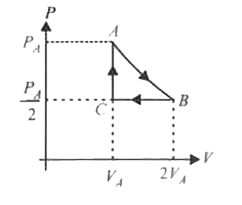 B
B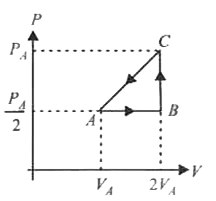 C
C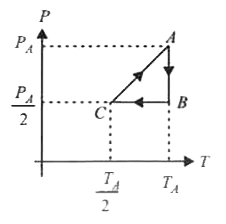 D
D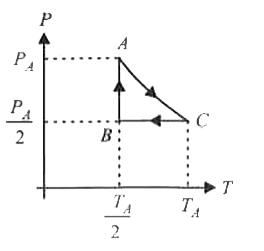
One mole of an ideal gas at pressure P0 and temperature T0 is expanded isothermally to twice ist volume and then compressed at constant pressure to (V0/2) and the gas is brought bac to original state by a process in which PαV (pressure is direclty proportional to volume). The correct temperature of the process is
A B
B C
C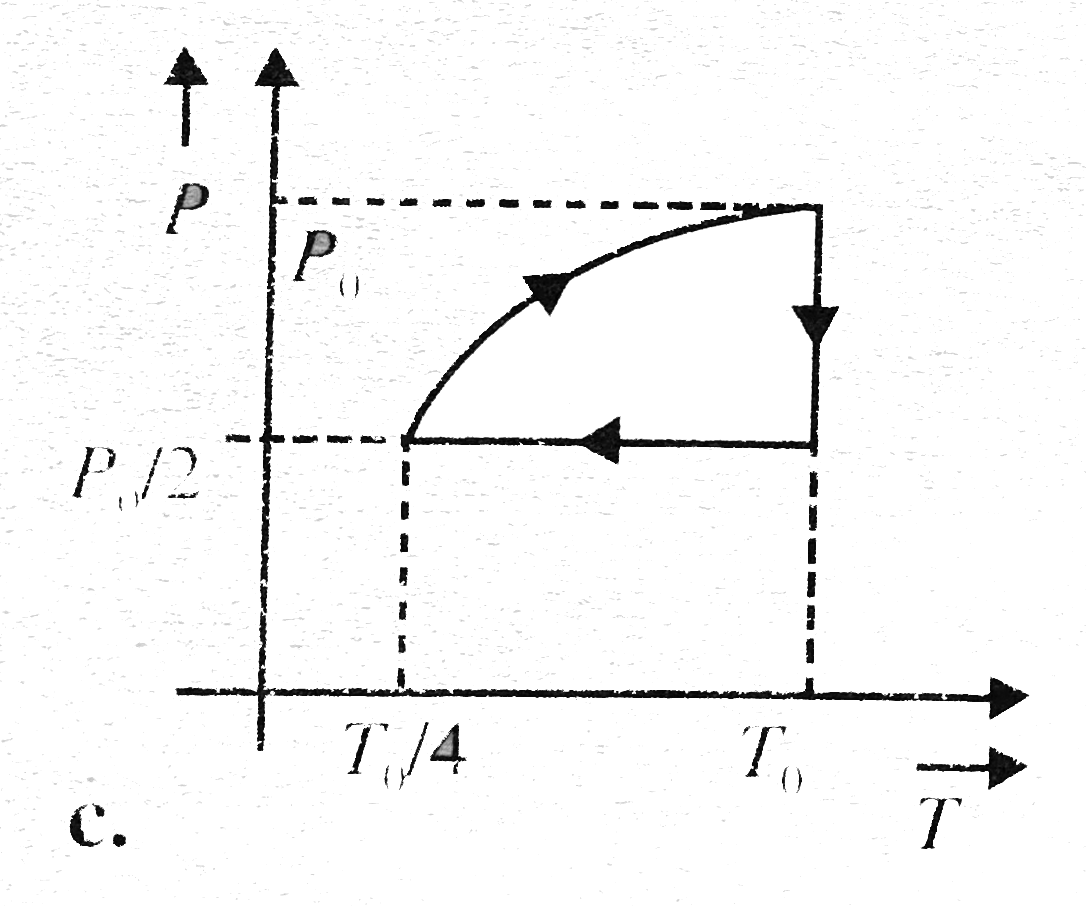 D
D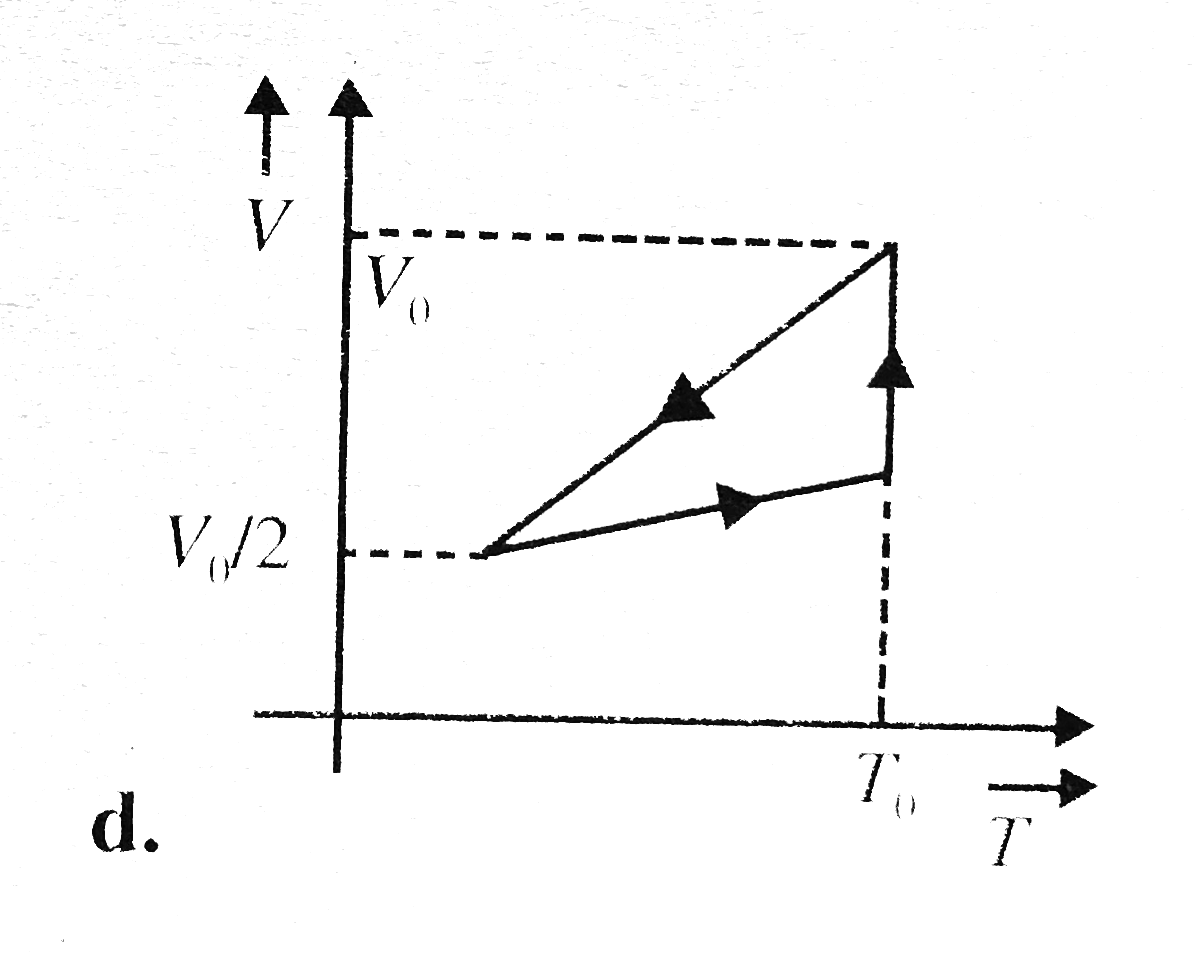
An ideal gas has volumeV0 at . 27∘C It is heated at constant pressure so that its volume becomes . 2V0.The final temperature is
A54∘CB32.6∘CC327∘CD150 k
Three moles of an ideal gas (Cp=7/2R) at pressure pA and temperature TA is isothermally expanded to twice its initial volume. It is then composed at constant pressure to its original volume. Finally the gas is compressed at constant volume to its original pressure pA (i) Sketch p−V and p−T diagrams for the complete process (b) Calculate the net work done by the gas and net heat supplied to the gas a during the complete process.
View SolutionThree moles of an ideal gas (Cp=72R) at pressure, PA and temperature TA is isothermally expanded to twice its initial volume. It is then compressed at constant pressure to its original volume. Finally gas is compressed at constant volume to its original pressure PA.
(a) Sketch P-V and P-T diagrams for the complete process.
(b) Calculate the net work done by the gas, and net heat supplied to the gas during the complete process.
View SolutionThree moles of an ideal gas (Cp=72R) at pressure p0 and temperature T0 is isothermally expanded to twice its initial volume. It is then compressed at a constant pressure to its original volume.
(a) Sketch p-V and p-T diagram for complete process.
(b) Calculate net work done by the gas.
(c) Calculate net heat supplied to the gas during complete process.
(Write your answer in terms of gas constant =R)
View SolutionAn ideal gas has pressure p0, volumn V0 and temperature T0. It is taken an isochoric process till its pressure is doubled. It is now isothermally expanded to get the original pressure. Finally , the gas is isobarically compressed to its original volume V0. (a) Show the process on a p-V diagram. (b) What is the tempertaure in the isothermal part of the process? (c) What is the volumn at the end of the isothermal part of the process?
View SolutionA monatomic gas at pressure P1 and volume V1 is compressed adiabatically to 1(8)th of its original volume. What is the ginal pressure of the gas ?
View Solution